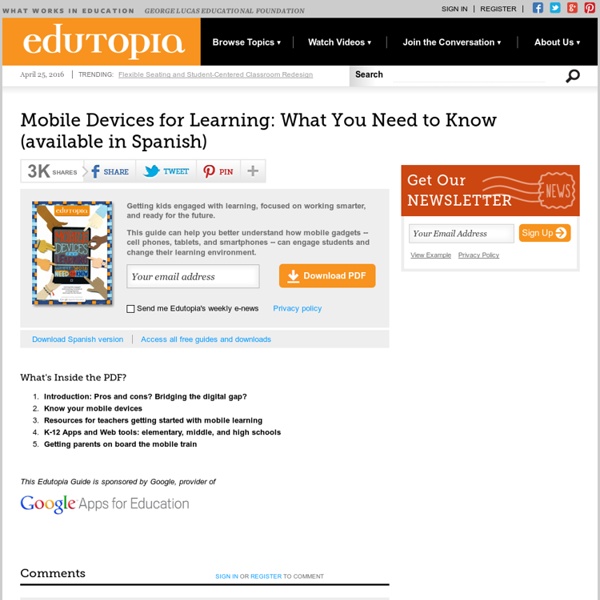



http://www.edutopia.org/mobile-devices-learning-resource-guide
Related: UNESCO Mobile learningMobile Learning Mobile Learning ©UNESCO/NOKIA | ©UNESCO/Pakistan project Today over 6 billion people have access to a connected mobile device and for every one person who accesses the internet from a computer two do so from a mobile device. Mobile technology is changing the way we live and it is beginning to change the way we learn. UNESCO is working to help governments and individuals use mobile devices to advance Education for All Goals; respond to the challenges of particular educational contexts; supplement and enrich formal schooling; and, in general, make learning more accessible, equitable and flexible for students everywhere. What is mobile learning?
Mobile Learning: 50+ Resources & Tips I believe mobile devices will transform education. This is why I created a free ebook, Effective Mobile Learning: 50+ Quick Tips & Resources with helpful tips and several resources to help support this trend. One reason is because mobile devices are designed in a way that forces the teacher to give control to the learner. Exploring Students' Mobile Learning Practices in Higher Education Key Takeaways A university-wide survey on students' mobile learning practices showed that ownership of mobile devices is high among students and that tablets are the most popular devices for academic purposes. The survey also found that mobile learning typically occurs outside the classroom, with only limited guidance from instructors. To improve mobile learning effectiveness, students and instructors need help adopting more effective learning and teaching practices across content areas. Baiyun Chen and Aimee deNoyelles are instructional designers at the University of Central Florida.
Information Systems & Technology Risks of Mobile Phones and Tablets Theft or loss Mobile phones, smart phones (phones that support email, documents, and applications) and tablets (such as iPads) are getting fancier and more popular all the time. Do mobile devices in the classroom really improve learning outcomes? Mobile devices as teaching tools are becoming a more and more common part of the American education experience in classrooms, from preschool through graduate school. A recent Pew Research Center survey found that 58% of U.S. teachers own smartphones — 10 percentage points higher than the national average for adults. Those teachers are building that tech-savviness into their lesson plans, too, by embracing bring-your-own-device policies and leading the push for an iPad for every student. In 2013, an estimated 25% of U.S. schools had BYOD policies in place and it’s reasonable to assume those numbers have risen in the past two years. What do these mobile devices really add, though?
12 Principles Of Mobile Learning 12 Principles Of Mobile Learning by Terry Heick Ed note: This post has been updated and republished from a 2012 post Mobile Learning is about self-actuated personalization. As learning practices and technology tools change, mobile learning itself will continue to evolve. Mobile Learning Guide Part 1: Designing it right Mobile learning has pushed beyond the ‘what if’ hype to ‘what now’. But how do you get there? We’ve identified a core set of learning design models to help internal teams. Learning to Go: Lesson Ideas for Teaching with Mobile Devices, Cell Phones, and BYOT Every day, people around the world communicate, connect, and learn digitally on the go. Our students spend hours with their devices and digital tools. Imagine if some of that time was spent learning your content.
How do mobile devices in the classroom impact student learning? Mobile devices are ubiquitous—including in the college classroom. Instructors across disciplines now compete with a host of electronic stimuli for students' attention. But to what extent is messaging interfering with student learning? Can students concentrate with the same intensity while exchanging texts with their friends and family?